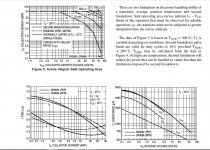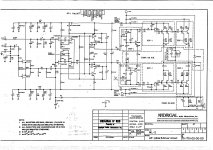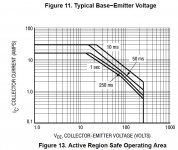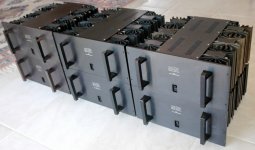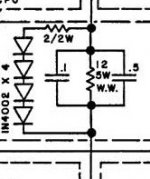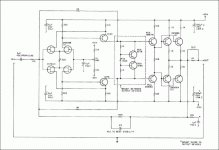Hi,
I've a pair of Levinson ML-2's wich have been serviced around 2000 and the original 50A (60V) powertransistors 2N5684/86 have been replaced by MJ15084/85 16A (250V) types.
Regulated railvoltage is kept at 27 Volts and max output voltage is 17 Volts.
For what it's worth: According to specs it should be stable @ loads around 1 Ohm and Apogee Acoustics wrote in the owners manual of the Apogee The Apogee (Fullrange) that you drive this planar with out the transformers:
From their manual:
"10. LOW IMPEDANCE DIRECT DRIVE
Introduction & Description
The APOGEE Acoustics Direct Drive is an alternate embodiment of the speaker. It is intended to take advantage of certain low power Class A Amplifiers with exceptional sonic merits, and still provide adequate dynamic range for most music. These amplifiers are capable of driving a 1 ohm load with no problem. If you have questions as to the adequacy of a particular product, consult your dealer or amplifier manufacturer.
The characteristics of the APOGEE Direct Drive are summarized as follows:
1) Typical Peak SPL's of 110 db with 25 watt Class A amplifiers into 8 ohms.
2) Speaker has a nominal impedance of 1.6 ohms.
3) Woofer and Tweeter are transformer-less.
4) All speaker connections are with Fisher Speaker Connectors.
5) The Passive Crossover supplied must be used for proper contouring.
6) Midrange / Tweeter adjustment resolution is 1/3 db.
Not hindered by any real technical understanding, common sense says to me that the best powertransistors is the original 2N5684/86 50A combo because with a railvoltage of max 30 Volts I will never need the 250 Volts of the MJ15024/25 or any other MJ high voltage transistors but the margin of amps is much greater.
The poweramplifier itself only operates 4 NPN/PNP powertransistor pairs.
They drive Infinity QLS speakers.
I know there's something as higher (switching) speed with the MJ types but do I need that?
I know that Nelson Pass favors big "slow" large can capicators and bridge rectifiers in his PSU's instead of fast small capacitors and fast switching diodes.
Any comments or thoughts will be appreciated.
I've a pair of Levinson ML-2's wich have been serviced around 2000 and the original 50A (60V) powertransistors 2N5684/86 have been replaced by MJ15084/85 16A (250V) types.
Regulated railvoltage is kept at 27 Volts and max output voltage is 17 Volts.
For what it's worth: According to specs it should be stable @ loads around 1 Ohm and Apogee Acoustics wrote in the owners manual of the Apogee The Apogee (Fullrange) that you drive this planar with out the transformers:
From their manual:
"10. LOW IMPEDANCE DIRECT DRIVE
Introduction & Description
The APOGEE Acoustics Direct Drive is an alternate embodiment of the speaker. It is intended to take advantage of certain low power Class A Amplifiers with exceptional sonic merits, and still provide adequate dynamic range for most music. These amplifiers are capable of driving a 1 ohm load with no problem. If you have questions as to the adequacy of a particular product, consult your dealer or amplifier manufacturer.
The characteristics of the APOGEE Direct Drive are summarized as follows:
1) Typical Peak SPL's of 110 db with 25 watt Class A amplifiers into 8 ohms.
2) Speaker has a nominal impedance of 1.6 ohms.
3) Woofer and Tweeter are transformer-less.
4) All speaker connections are with Fisher Speaker Connectors.
5) The Passive Crossover supplied must be used for proper contouring.
6) Midrange / Tweeter adjustment resolution is 1/3 db.
Not hindered by any real technical understanding, common sense says to me that the best powertransistors is the original 2N5684/86 50A combo because with a railvoltage of max 30 Volts I will never need the 250 Volts of the MJ15024/25 or any other MJ high voltage transistors but the margin of amps is much greater.
The poweramplifier itself only operates 4 NPN/PNP powertransistor pairs.
They drive Infinity QLS speakers.
I know there's something as higher (switching) speed with the MJ types but do I need that?
I know that Nelson Pass favors big "slow" large can capicators and bridge rectifiers in his PSU's instead of fast small capacitors and fast switching diodes.
Any comments or thoughts will be appreciated.
2n5684/86 still available really?
Dont think so?
Regards
David
Also from Digikey.
2N5684G ON Semiconductor | Discrete Semiconductor Products | DigiKey
91
Can ship immediately
Who serviced them? Audiac?
Original power transistors still available from Onsemi.
Thanks, yes I know that you can still get them.
Bought them 10 years ago in Germany so they're probably serviced by Sun Audio.
Question is why did they choose for the MJ15024/25 transistors?
http://www.diyaudio.com/forums/attachment.php?attachmentid=592068&stc=1&d=1484411847
http://www.diyaudio.com/forums/attachment.php?attachmentid=592069&stc=1&d=1484411847
http://www.diyaudio.com/forums/attachment.php?attachmentid=592070&stc=1&d=1484411847
Last edited:
Do you have a schematic?
Why not use what was designed to go in there since you can get them.
The repair shop probably used what they had on hand.
I remember seeing the 2n5684/86 in the data books years ago, what is the
story are they double die or something? Too bad they don't have good SOA
up around 60V, great at 30V.
Why not use what was designed to go in there since you can get them.
The repair shop probably used what they had on hand.
I remember seeing the 2n5684/86 in the data books years ago, what is the
story are they double die or something? Too bad they don't have good SOA
up around 60V, great at 30V.
Last edited:
I first used the 2N5684/6 back in 1969, and told Mark about them, but they only like +/- 25V operation, because they have bad 'safe area' about 30V or so and +/-30V is too much. That is probably why it needed repair in the first place. I originally used the 2N5884/6 and these had slightly better safe area, but worked well. I would leave well enough alone if it is not further broken. The 2N5684/6 were not the best devices with this circuit.
Do you have a schematic?
Why not use what was designed to go in there since you can get them.
The repair shop probably used what they had on hand.
I remember seeing the 2n5684/86 in the data books years ago, what is the
story are they double die or something? Too bad they don't have good SOA
up around 60V, great at 30V.
Thanks. I do not know if the have a double die but these are the graphs:
http://www.diyaudio.com/forums/attachment.php?attachmentid=592240&stc=1&d=1484475202
and the schematic:
http://www.diyaudio.com/forums/attachment.php?attachmentid=592241&stc=1&d=1484475202
Attachments
Thank you John for stepping in.I first used the 2N5684/6 back in 1969, and told Mark about them, but they only like +/- 25V operation, because they have bad 'safe area' about 30V or so and +/-30V is too much. That is probably why it needed repair in the first place. I originally used the 2N5884/6 and these had slightly better safe area, but worked well. I would leave well enough alone if it is not further broken. The 2N5684/6 were not the best devices with this circuit.
What would you recommend or indicate what the best devices would be in your design,pressuming your design for the JC-3 isn't that different from the design Thomas Colangelo finished as the ML-2.
ML-2 Response
If you upgrade to the MJ15024/25 you will have to change the transistor sockets on the heat sinks. The leads are a larger diameter on the 2N5486's than the MJ15024's. I am restoring 3 pairs at the moment. regards ml7anut
Hi,
I've a pair of Levinson ML-2's wich have been serviced around 2000 and the original 50A (60V) powertransistors 2N5684/86 have been replaced by MJ15084/85 16A (250V) types.
Regulated railvoltage is kept at 27 Volts and max output voltage is 17 Volts.
For what it's worth: According to specs it should be stable @ loads around 1 Ohm and Apogee Acoustics wrote in the owners manual of the Apogee The Apogee (Fullrange) that you drive this planar with out the transformers:
From their manual:
"10. LOW IMPEDANCE DIRECT DRIVE
Introduction & Description
The APOGEE Acoustics Direct Drive is an alternate embodiment of the speaker. It is intended to take advantage of certain low power Class A Amplifiers with exceptional sonic merits, and still provide adequate dynamic range for most music. These amplifiers are capable of driving a 1 ohm load with no problem. If you have questions as to the adequacy of a particular product, consult your dealer or amplifier manufacturer.
The characteristics of the APOGEE Direct Drive are summarized as follows:
1) Typical Peak SPL's of 110 db with 25 watt Class A amplifiers into 8 ohms.
2) Speaker has a nominal impedance of 1.6 ohms.
3) Woofer and Tweeter are transformer-less.
4) All speaker connections are with Fisher Speaker Connectors.
5) The Passive Crossover supplied must be used for proper contouring.
6) Midrange / Tweeter adjustment resolution is 1/3 db.
Not hindered by any real technical understanding, common sense says to me that the best powertransistors is the original 2N5684/86 50A combo because with a railvoltage of max 30 Volts I will never need the 250 Volts of the MJ15024/25 or any other MJ high voltage transistors but the margin of amps is much greater.
The poweramplifier itself only operates 4 NPN/PNP powertransistor pairs.
They drive Infinity QLS speakers.
I know there's something as higher (switching) speed with the MJ types but do I need that?
I know that Nelson Pass favors big "slow" large can capicators and bridge rectifiers in his PSU's instead of fast small capacitors and fast switching diodes.
Any comments or thoughts will be appreciated.
If you upgrade to the MJ15024/25 you will have to change the transistor sockets on the heat sinks. The leads are a larger diameter on the 2N5486's than the MJ15024's. I am restoring 3 pairs at the moment. regards ml7anut
If you upgrade to the MJ15024/25 you will have to change the transistor sockets on the heat sinks. The leads are a larger diameter on the 2N5486's than the MJ15024's. I am restoring 3 pairs at the moment. regards ml7anut
I know see my review: Mark Levinson ML-2 : HighEndClassics.com
Leads of the 2N5486: 1,45 ~ 1,60 mm
Leads of the 2N5486: 0,97 ~ 1,09 mm
Probably has something todo with the greater currentcapability?
The MJ15024/25 are already so probably Sun Audio solved that problem.
Which transistors you're gonna use for the restoringproces of the ML-2's
Great you're restoring them. I think it's the most important/influential highend solidstate amp. Let's keep the alive!
If you need any information I'm gladly to provide you with it.
Last edited:
Interesting that you posted the SOA curve and I already mentioned that the original parts
will handle 10A at 30V, very good, but note that the constant power slope of the curve has
two breaks as voltage increases. At 60V the devices only handle 1A, they are derated to
just 60W. Now look at the replacement parts they will handle 5A at 60V much more than
the original parts. If you think of the output devices just turning on for their half cycle of
the output swing you might think that the current rating above 30V doesn't matter, however
when the output goes to the opposite rail and the transistor has to discharge the large
device capacitance and possibly load capacitance that is keeping it there. Newer devices
might be better for this reason. However if you need the amp to drive 1 ohm loads you
might want to do some worst case calculations on the peak current rating needed for the
output devices.
The issue of pulling the output from the opposite rail will be worst case when the amp is
driven by fast square waves or deeply into clipping.
will handle 10A at 30V, very good, but note that the constant power slope of the curve has
two breaks as voltage increases. At 60V the devices only handle 1A, they are derated to
just 60W. Now look at the replacement parts they will handle 5A at 60V much more than
the original parts. If you think of the output devices just turning on for their half cycle of
the output swing you might think that the current rating above 30V doesn't matter, however
when the output goes to the opposite rail and the transistor has to discharge the large
device capacitance and possibly load capacitance that is keeping it there. Newer devices
might be better for this reason. However if you need the amp to drive 1 ohm loads you
might want to do some worst case calculations on the peak current rating needed for the
output devices.
The issue of pulling the output from the opposite rail will be worst case when the amp is
driven by fast square waves or deeply into clipping.
Interesting that you posted the SOA curve and I already mentioned that the original parts
will handle 10A at 30V, very good, but note that the constant power slope of the curve has
two breaks as voltage increases. At 60V the devices only handle 1A, they are derated to
just 60W. Now look at the replacement parts they will handle 5A at 60V much more than
the original parts. If you think of the output devices just turning on for their half cycle of
the output swing you might think that the current rating above 30V doesn't matter, however
when the output goes to the opposite rail and the transistor has to discharge the large
device capacitance and possibly load capacitance that is keeping it there. Newer devices
might be better for this reason. However if you need the amp to drive 1 ohm loads you
might want to do some worst case calculations on the peak current rating needed for the
output devices.
The issue of pulling the output from the opposite rail will be worst case when the amp is
driven by fast square waves or deeply into clipping.
Great relevant information, thank you for this.
Actually the MJ15024/25 will handle 4 Amps at 60 Volts and 5 Amps at 50 Volt that's why they're rated as 250 Watt devices.
But I won't substitute the already configured MJ15024/24 complementair decives for 2N5684/86 because I do not have to drive an Apogee directly.🙂
How about the MJ21195/96?
http://www.diyaudio.com/forums/attachment.php?attachmentid=592451&stc=1&d=1484579064
@ approx. 12 Volts 11 Amps and @ 60 Volts still 4 Amps?
Attachments
If you upgrade to the MJ15024/25 you will have to change the transistor sockets on the heat sinks. The leads are a larger diameter on the 2N5486's than the MJ15024's. I am restoring 3 pairs at the moment. regards ml7anut
You mean this lot:
http://www.diyaudio.com/forums/attachment.php?attachmentid=592460&stc=1&d=1484579554
😉
Attachments
Great relevant information, thank you for this.
Actually the MJ15024/25 will handle 4 Amps at 60 Volts and 5 Amps at 50 Volt that's why they're rated as 250 Watt devices.
But I won't substitute the already configured MJ15024/24 complementair decives for 2N5684/86 because I do not have to drive an Apogee directly.🙂
How about the MJ21195/96?
http://www.diyaudio.com/forums/attachment.php?attachmentid=592451&stc=1&d=1484579064
@ approx. 12 Volts 11 Amps and @ 60 Volts still 4 Amps?
Note also the the curves for the modern devices are pulsed, that one for 1 sec and
that test condition yields better results so they should be derated a bit.
My opinion is that the amp was known for driving 1 ohm loads and that should
be retained. If the outputs could saturate to 0V the current would be 27V/1R
obviously 27 amps, with a 2V saturation that will be 25A. They built it with a
lot of margin. The load helps bring the voltage back to zero and to keep the
outputs from going deep into saturation.
Note also the the curves for the modern devices are pulsed, that one for 1 sec and
that test condition yields better results so they should be derated a bit.
My opinion is that the amp was known for driving 1 ohm loads and that should
be retained. If the outputs could saturate to 0V the current would be 27V/1R
obviously 27 amps, with a 2V saturation that will be 25A. They built it with a
lot of margin. The load helps bring the voltage back to zero and to keep the
outputs from going deep into saturation.
So basically you advocate to use the original 2N5684/86 devices for the Levinson ML-2and not substitute them with MJ15024/24 or MJ21195/96 if I'm correct?
Robert, stick with the devices now in the unit. They are exceptionally qualified for this service, as they have very good safe area at medium voltages, good enough peak current, and only 4MHz f(t), because some newer devices might oscillate in this amp as it is configured. Of course, when the new devices were put in, either the transistor sockets had to be replaced or repaired for the smaller pin diameter of the later devices, but so what?
When the 5684/86 were first developed, I suspect they were made originally for some military project to handle very high current at low voltages, but their rather lousy safe area (second breakdown prone) made them unreliable for more than +/- 25V operation or even less. Mark used these parts because they were so impressive looking, not realizing that they had a lower safe area than the 2N5884/6 that I originally supplied with the JC-3 (the prototype of the ML-2). Big mistake.
When the 5684/86 were first developed, I suspect they were made originally for some military project to handle very high current at low voltages, but their rather lousy safe area (second breakdown prone) made them unreliable for more than +/- 25V operation or even less. Mark used these parts because they were so impressive looking, not realizing that they had a lower safe area than the 2N5884/6 that I originally supplied with the JC-3 (the prototype of the ML-2). Big mistake.
- Status
- Not open for further replies.
- Home
- Amplifiers
- Solid State
- Levinson ML-2 preferred power transistors
